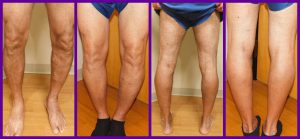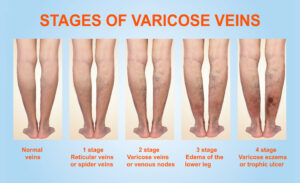Varicose Vein Treatment
Treatment of leg vein disorders has changed dramatically in the past few years. New technologies to eliminate troublesome surface veins have almost completely replaced conventional “stripping”.
Roughly 25% of women and 15% of men suffer from the pain and anxiety caused by varicose or spider veins. New non-surgical laser treatments allow for fast treatments, requiring minimal recovery time.
Varicose Veins
Healthy veins return blood to the heart so it can be re-oxygenated. One-way valves within the veins ensure that the blood flows in one direction—toward the heart. When valves fail or leak, the blood flows backwards, causing blood to pool in the veins. The increased pressure from the pooling stretches the vein, causing enlarged, twisted blood vessels. The resulting bumpy, rope like veins are varicose veins.
It normally takes years for symptoms of varicose veins to develop. While varicose veins are commonly inherited, anyone can get them. Hormonal changes brought on by puberty, pregnancy, and menopause can trigger the onset of varicose veins.
Varicose veins can cause swelling in the legs and feet, create a sense of fatigue in leg muscles, and cause leg throbbing or cramping. Often, the skin surrounding the varicose veins frequently itches and burns.
Symptoms
Left untreated, varicose veins can lead to swelling, increased pain, skin discoloration, and ulcerations of the lower legs. These ulcerations are difficult to treat, and can become easily infected and painful. Many of these symptoms and complications can be prevented by early treatment of varicose veins.
Pain in the legs is frequently related to varicose veins. Symptoms are often made worse by standing and sitting for periods of time. Symptoms include swelling, leg fatigue, aching, burning, cramping and restlessness of the legs. Severe varicose veins can compromise the nutrition of the skin and lead to eczema, inflammation or even ulceration of the lower leg.
Diagnosis
Vein disorders are not always visible; therefore, modern diagnostic techniques are important tools in determining the cause and severity of the problem. Depending on the results of your screening examination, your doctor may recommend additional tests, such as diagnostic ultrasound, to identify where and how badly your veins are damaged. The ultrasound examination is designed to evaluate the blood flow through your veins in your legs, localizing the problem areas.
Endovenous Laser Therapy Treatment
The actual procedure to remove varicose veins is commonly referred to as Endovenous Laser Therapy (EVLT). This procedure normally takes less than an hour and only requires local anesthesia.
By delivering just the right wavelength of laser energy to just the right tissue, the incompetent veins (varicose veins) will close. Your body automatically routes the blood to other healthy veins.
While you might feel some unfamiliar sensation, the procedure produces only a mild degree of pain or discomfort for most patients.
Phases of Treatment
-
1. Level 1 Visit
-
During this visit, an exam is performed to assess the extent of your veins. If you have large or suspicious varicosities, an ultrasound will be scheduled to establish the veins responsible for your condition.
If you appear to only have spider veins, you still might need an ultrasound exam to rule out larger vein involvement.
This appointment is used to obtain a complete medical history and thorough examination. This visit is billed through insurance at contracted rates, or self-pay at $106.
-
2. Ultrasound
-
The ultrasound is a critical step to determine the abnormal veins that are contributing to the appearance and symptoms you are experiencing. This can be performed on one or both legs, depending on your symptoms.
Due to the thorough nature of the exam, the ultrasound usually takes approximately 60 to 90 minutes to complete.
-
3. Treatment Plan
-
During this Level 2 visit, your treatment plan will begin. The Vanishing Veins Northwest professional staff will explain the results of your ultrasound. Then you will discuss your options for treatment, including risks and benefits.
At this time, a short physical exam is performed to rule out any unforeseen problems or changes in the medical status.
-
4. Financial Consultation
-
Our billing experts will go over the process for submitting an insurance claim with you. Authorization from insurance companies for your treatment can take anywhere from three days to six weeks, depending on your insurance carrier.
You will need to sign both an Advanced Beneficiary Notice and an Informed Consent prior to treatment. You will be provided these forms during this visit.
-
5. Treatment (EVLT)
-
Prior to arriving for your exam, you will have applied the topical anesthetic crème, EMLA. You will also have taken your prescribed mild anti-anxiety medication, Xanax (Alprazolam), used for short-term relief of nervousness related to the process.
- Upon arrival, you will be taken to an exam room to change into a patient robe. The performing physician will come in and review the process and answer any questions that you might have.
- You will then go the procedure room. A quick ultrasound will be performed to identify the best site for doctor to access the vein in your leg.
- A member of the team will wash your leg with a sterilizing solution. Sterile drapes will be placed at the site to reveal only the areas of the leg where the procedure will occur.
- The vein will be accessed and a series of fine wires and sheaths will be used to properly position the laser fiber in the vein to be treated.
- Anesthesia is placed around the vein. This creates a thermal fluid barrier so the heat from the laser will treat only the abnormal vein.
- The laser is activated and withdrawn from the vein, leading the closure of the varicosity. This step takes approximately two to three minutes.
- Pressure is held at the access site for a brief time to stop any bleeding.
- After your compression hose is applied to your leg, you are finished.
-
6. Follow-up Ultrasound
-
An ultrasound exam is performed 36 – 72 hours after the procedure to assess for any complications, such as blood clots formed along the site. This exam takes approximately 30 minutes.
-
7. Follow-up Visits
-
The Vanishing Veins Northwest staff would like to see you six weeks after your procedure to review your progress and to determine if further treatment is needed.
FAQs
-
1. Exactly how does a laser treat varicose veins?
-
Your veins carry blood from the capillaries to the heart. In your leg, this means the blood has to flow upward, against gravity. Consequently, these veins have one-way valves to prevent the blood from back flowing. Over time, these valves can fail to close tightly, allowing blood to pool and causing the bulging and twisting characteristic of varicose veins.
Endovenous Laser Therapy (EVLT) fixes this problem at the source by delivering just the right wavelength of laser energy to just the right tissue, causing the incompetent vein to close. Your body automatically routes the blood to other healthy veins.
-
2. How is laser treatment different from surgery?
-
Surgery involves considerable preparation, general anesthesia, the risk of infection, pain in the affected areas, and a lengthy recovery period. The medical laser technology used in EVLT eliminates all of that.
The procedure is minimally invasive. The entry point through which your physician gets the laser fiber to the target area is extremely small, not even requiring stitches.
There is no recovery to speak of. In fact, you’ll be up and walking as soon as it is over, and will be able to return to normal activity quickly.
The risk of infection is extremely low.
-
3. I've heard about lasers being used in medicine but I'm not sure how they work. Are they safe?
-
Simply put, a laser is a highly concentrated beam of light. Medical lasers work by delivering this light energy to the targeted tissue with extreme precision, so as to not affect the surrounding tissue. They’ve proven their safety and effectiveness through years of use in all kinds of medical procedures—from ophthalmology to dermatology. In the hands of a skilled physician, lasers offer far less risk and complications than conventional surgery.
-
4. What is the actual procedure like?
-
It takes about 45 minutes and requires just local anesthesia. Your physician then inserts a thin laser fiber into the vein through a sheath; the laser light is emitted through that fiber. While you might feel some unfamiliar sensation, it is not painful. And it’s all done in an outpatient setting, similar to your physician’s office or a one-day surgery center.
-
5. I have a question about the results of my examination.
-
Vrads.com does not include medical results for diagnostic imaging exams for patients. We recommend that you ask your doctor or health services provider about the results of your examination.
-
6. How long will the results last?
-
You should experience no reoccurrence in the veins that have been treated. Follow-up procedures may be desired to obtain optimal aesthetic results.
-
7. Will my insurance cover the treatment?
-
Check your policy and call your insurance provider to find out what their exact coverage will be.



